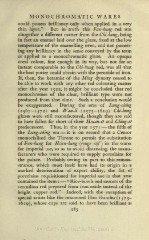Page 351 - Oriental Series Japan and China, Brinkly
P. 351
MONOCHROMATIC WARES
could possess brilliancy only when applied in a very
thin layer." But in truth this Fan-hung red was
altogether a different matter from the Chi-hung, being
in fact an enamel laid over the glaze, fixed at the low
temperature of the enamelling oven, and not possess-
ing any brilliancy in the sense conveyed by the term
as applied to a monochromatic glaze. An opaque
coral colour, fine enough in its way, but not for an
instant comparable to the Chi-hung red, was all that
the best potter could obtain with the peroxide of iron.
If, then, the keramist of the Ming dynasty ceased to
be able to work with any other red colouring matter
after the year 1522, it might be concluded that red
monochromes of the clear, brilliant type were not
produced from that time. Such a conclusion would
be exaggerated. During the eras of Lung-ching
(15671572) and Wan-li (1573 1619) Chi-hung
glazes were still manufactured, though they are said
to have fallen far short of their Hsuan-te and Ching-ti
predecessors. Thus, in the year 1571 the fifth of
the Lung-ching era it is on record that a Censor
memorialised the Throne to permit the substitution
of Fan-hung for Hsien-hung (rouge vif) in the wares
for imperial use, so as to avoid distressing the manu-
facturers who were required to supply porcelains for
the palace. Probably owing in part to this remon-
strance, which must itself have had its origin in a
marked deterioration of expert ability, the list of
porcelains requisitioned for imperial use in that year
contained the item : " Rice-bowls and saucers of the
vermilion red prepared from iron oxide instead of the
bright copper red." Indeed, with the exception of
special artists like the renowned Hao Shi-chu (1573
1619), whose cups are said to have been brilliant as
285

